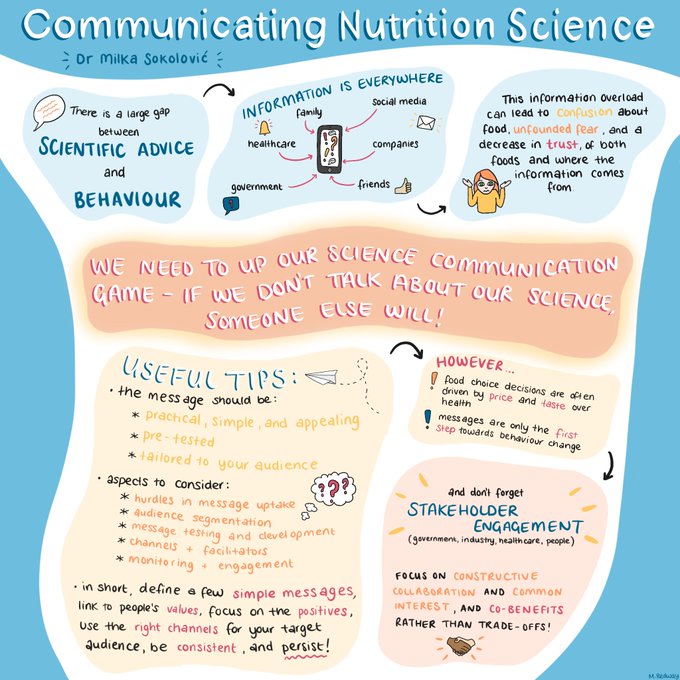Dr Milka Sokolović is Head of Food & Health Science at EUFIC and Director Advanced Programme ENLP. On 5th October 2020 she was invited to present for the first ENLP webinar and spoke about “Nutrition science, stakeholders & impact: is communication the missing link?”
Worldwide, with 1.9 billion of us suffering from overweight & obesity, the public health problem of unbalanced diets keeps pressing. The well-established science-based messages to encourage heathier eating habits, such as reducing consumption of salt, sugar and fat and increasing intakes of fruits, vegetables and wholegrain, provide a seemingly simple solution to much of the malnutrition burden. Despite the food-based dietary guidelines tailored to populations’ specificities and habits being developed for almost all countries, diets high in sodium and low in wholegrains, fruit and veg, nuts, seeds and fibre are the highest contributors to global food-related morbidity and mortality. So, how can we address this huge gap between the healthy eating guidelines and behaviour?
Milka outlined the issues that surround nutrition science communication including information overload (not only from media, but from governments, non-governmental organisations (NGOs), friends and family, as well as healthcare professionals), leading to confusion, fear and eventual lack of trust in nutrition science by general public.
What can we do to close this gap?
Despite the challenges that it faces – from the evolutionary nature of science, to the diversity of the recipients – effective communication of accurate and actionable information remains a priority.
To make our communication efficient, Milka recommends we:
- define (a few!) simple actionable messages
- link to people‘s values
- focus on positives
- use the right channels
- be consistent
- persist
In contrast to scientific writing, we should:
- use everyday words
- use active verbs
- make our sentences “sweet & short” (15-20 words)
- give information in a logical order
- use lists & bullet points
- be personal & polite
- include lots of visuals!
In communicating about healthy diets, we should recognise that food choice is primarily affected by taste, then price, followed by health as only the third concern. We not only need ways to persuade the public that healthy food can also taste good and be cost-effective, but we should ensure conditions in a broader environment for a behaviour change, such as offering more healthier food choices and more exercise opportunities.
To ensure the impact of nutrition science, we hence must engage with stakeholders – yet another “soft skill” that scientists and nutrition professionals are expected to be “natural” in. To crunch it, Milka takes us to the basics of engaging stakeholders, starting from identifying who are stakeholders might be:
- Who? anyone that can affect or is affected by our project/initiative
- Why? to satisfy their needs, gain approval & support, or minimise their opposition
- When? crucial in initial stages of the project/initiative, when establishing success criteria & securing a buy-in
- What? consult, listen, understand, communicate, influence, negotiate.
The key principles of stakeholder engagement are trust and buy-in, and to achieve them we need to:
- Communicate, with clear objectives and good coordination
- Understand and define success – for all stakeholders, and early in the initiative
- Consult early and often, to collect information and exchange ideas, to gain support and to show that we value everyone’s views
- Plan and resource engagement
- Build relationships to gain support (time-intensity of which should be carefully factored in)
- Remember, we are all human, and our feelings – of support, indifference, opposition –will determine the success or failure of the initiative
- Be ready to compromise, as diverging or diametrically opposing views & interests can jeopardize the programme.
In essence, if we communicate well about nutrition and engage the right audiences, we can inspire:
- governments & public health authorities to engage stakeholders and reach health targets
- industry/companies to strive for further optimization of their food products
- health care professionals to educate people and drive the behaviour change
- media and NGOs to work in the interest of people and support raising population awareness
- people to make healthier lifestyle choices
Finally, to increase impact, Milka recommends that we leave our ‘nutri-silo’ and think outside the box by engaging with other experts, such as behaviour and environmental scientists, psychologists, educators, communicators, to achieve the most effective and impactful nutrition communication.
Short infographic summary below:
We would like to thank Dr Ann Ashworth for writing this blog post and Martha Redway for preparing the infographic.


